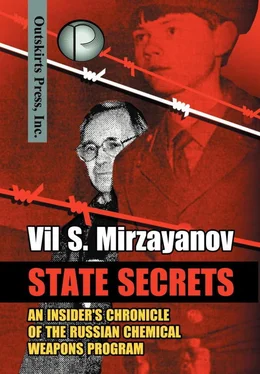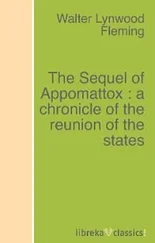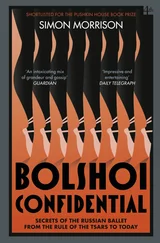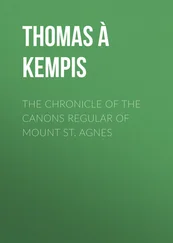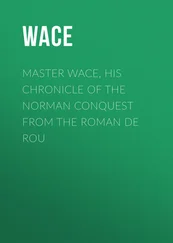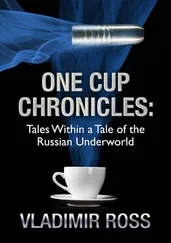For more on this accident, Will Englund, “Russia still doing work on chemical arms”, The Baltimore Sun , October 18 1992; Oleg Vishnyakov, “I Was Making Binary Bombs,” Novoe Vremya 50, December 1992, 46-9, trans. in FBIS-SOV-92-242, 16 November 1992, 25.
The work was done under the Central Committee and the Council of Ministers Resolution no. 844-186, 6 October 1989 and Ministry of Industry Decree no. 22-2, 9 December 1989. In Annex 21, see Top Secret Letter no. 1846 ss from Martynov to Shabunin, 24 November 1992; in Annex 31 see also “The Technical Order for the Compound Part of the Experimental Design Work of ‘Substance A-232’ On the Basis of the System of Components; The Code ‘Novichok-5,’” Top Secret Document 2187 ss/khf, signed on 4 May 1990 by GOSNIIOKhT Director V.A. Petrunin, on 27 April 1990 by Chief of 4984 VP MO E.A. Umbliya, on 16 May 1990 by Chief of 458 VP MO N.G. Ragulin, and on 16 May 1990 by NPO Basalt Director A. S. Obukhov. (Moscow: Russian State Scientific Research Institute for Organic Chemistry and Technology, 4 April 1990).
See the 23 September 1989 Wyoming Memorandum of Understanding between the United States and the USSR, which provided for data on their respective stockpiles to be exchanged in two phases and for a joint verification experiment.
There is every reason to believe that the dioxin which was used for poisoning in 2004 Viktor Yushchenko, that time presidential candidate of Ukraine, was produced in this institute.
To qualify for this Lenin Prize, Petrunin and his cohorts had to have solid proof that they had designed, tested, certified, and begun mass production of the Substance 33 binary, complete with the signatures of the relevant factory managers. Otherwise, the application for the award would not meet the standard of being a great accomplishment worthy of the Lenin Prize. See also the comments of Vladimir Uglev in Oleg Vishnyakov’s article, “Interview with a Noose Around the Neck,” Novoe Vremya , No 6 (1993): 41-2.
On 10 April 1987, Mikhail Gorbachev announced during a visit to Prague that the USSR was no longer making chemical weapons and had never deployed chemical weapons outside of its own territory. Jackson Diehl, “Gorbachev Proposes New Missile Talks; Short-Range Rockets Would Be Negotiated,” Washington Post , 10 April 1987, A1.
In addition to V. Petrunin, the Lenin Prize was given to S.A. Arzhakov, A.V. Gaev, A.V. Kisletsov, A.D. Kuntsevich, S.V. Petrov, E.S. Severin, V.I. Sichevoi. It is not surprising that not one of these “laureates” really worked on this problem. Such was Soviet style of life.
For a long time it was known as Voroshilov Military Academy of Chemical Defense.
Later he was transferred to the KGB and even participated in the search of the apartment of Lev Fedorov, my co-author of the article “A Poisoned Policy”. See Annex 8.
According to these regulations, the linear velocity of the air sucked by the ventilation into the laboratory exhaust hood had to be at least 1.0 meter per second to guarantee the safety of personnel. Every exhaust hood has a chart attached to it where the date and the last measured air velocity are logged, and if these measurements are lower than the standard norms, any operations with chemical agents must be terminated.
Some people in the U.S. are telling me that Substance 33 or VX-gas could not cause cancer, but they are forgetting that Substance 33 never was a pure product. It was a chemical agent of about 80% purity, contaminated with a lot of other compounds. Among them there were also some products of composition with three and more sulfur atoms.
These solutions were so ineffective that they did not even destroy the chemical agents to the level of permissible concentration, and that is a major safety shortcoming.
I was not the only chemist to note the deficiencies of the decontamination solution that the Russian Army continues to employ. General Nikolai Antonov, the former commander of Military Unit 61469, has also written about this problem. See N. S. Antonov, Khimicheskoe oruzhie na rubezhe dvukh stoletii, Progress (Moscow: 1994): 64. These terribly insufficient decontamination methods caused me to publicly oppose the plans of Ministry of Chemical Industry, which was planning to use the factory at Novocheboksarsk to destroy chemical weapons. Unit 83 in this factory produced Substance 33, and the walls of this facility remain irreversibly contaminated with Substance 33. Nevertheless, V. P. Ivanov, the Minister of Chemical and Petrochemical Industry accused me of significantly increasing the costs of Russia’s chemical weapons destruction program if the Novocheboksarsk facility could not be used. See Annex 51 for the full text of secret letter no. 629 from V. P. Ivanov, Chairman of Committee for Chemical and Petrochemical Industry to S.D. Balashov, Head of the Investigation Department at the Ministry of Security of The Russian Federation, pertaining to case no. 62 (Moscow: 13 April 1993).
In collaboration with Dr. Igor Revelsky, I conducted research that demonstrated the hazards of GOSNIIOKhT’s ventilation system. The reports that our two laboratories produced on this problem were ignored because an entirely new ventilation system would have to be designed to fix the problem. The cost of this monumental task was more than the system could bear.
The Main Laboratory Building was constructed in 1961. In 1987, I performed chromatomass-spectrometric analysis of water samples from the artesian well beneath the pilot plant facility. This well supplied many buildings of GOSNIIOKhT with water. My analysis showed the presence of many sulfur-containing decomposition products of mustard gas in significant quantities. Workers operating the excavating machines to prepare the site for new buildings experienced symptoms of poisoning from unknown substances. At last several events with serious poisoning of workers convinced the chief engineer to order the excavations to proceed under the supervision of experienced chemists, sometimes in gasmasks.
For example, four air samples were taken from chimney stack number 606A. The first contained 10 times the maximum permissible concentration, the second 50, the third 57, and the fourth 80 times the maximum permissible concentration.
After decontamination operations, water was kept in this tank for a fixed time, in a medium of excess alkali solution, to destroy the chemical agents entirely. After that, the contents of the tank were mixed with waste effluents from the production of agricultural chemicals and were thrown outside the plant. I have to mention that for this flawed technology of sarin, V.D. Belyaev, A.V. Bruker, S.L. Varshavski, S.N. Kosolapov, L.A. Kostandov, B. P. Kuchkov, B. Ja. Libman, V.V. Pozdnev, S.N. Potapov, L.Z. Soborovski, and N.N. Yukhtin received Lenin Prize in 1961. From that time, nothing changed in relation to the production of these extremely poisonous waste waters, but it didn’t prevent others from receiving the next Lenin Prize. This time: S.V. Golubkov, I. L. Knunyants, I.V. Martynov, I.M. Milgotin, A.P. Tomilov, V.N. Topnikov, and V.M. Zimin were awarded it for production of soman.
More detailed information was published in: Vechernij Volgograd, June 1 and 3, 1993; Izvestia , December 2, 1993.
Читать дальше
